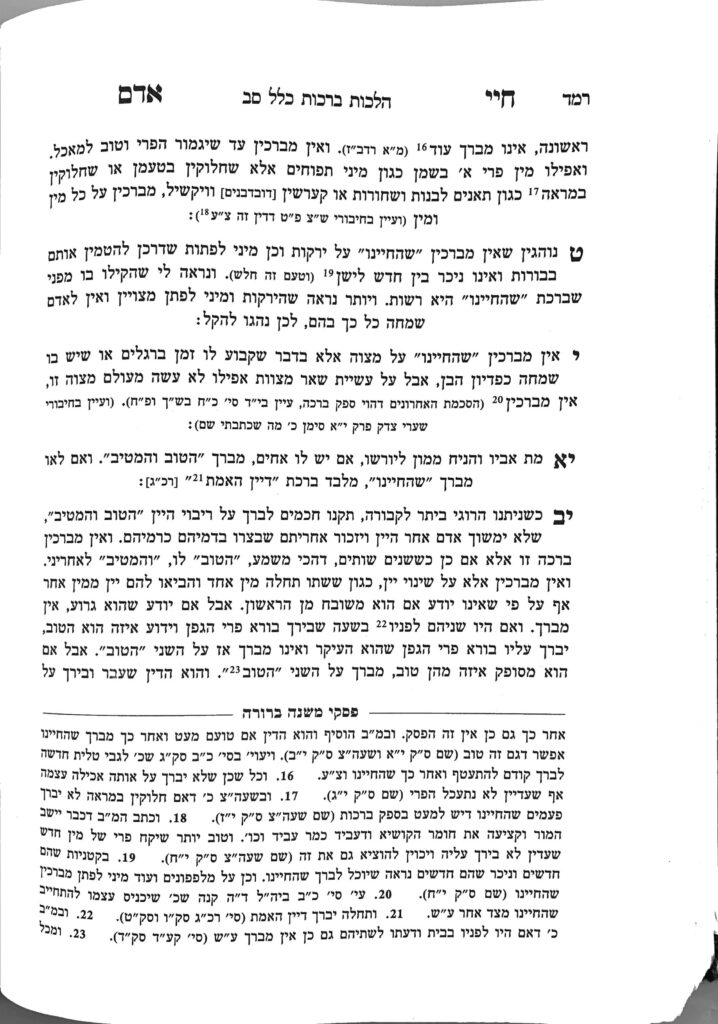We are beginning siman 10, which discusses reciting shehecheyanu on mitzvos. We have learned (shiur 1193) that shehecheyanu is made on mitzvos due to their cyclical element. We make a shehecheyanu both on the yom tov itself and for the mitzvos associated with it. Thus, for example, when one makes a shehecheyanu on Pesach or Sukkos, it covers both the yom tov and the mitzvos associated with it. When it comes to Purim and Chanukah, which are derabanan, we do not make a shehecheyanu for the holiday itself, as it is not deoraysa. The shehecheyanu is only for the mitzvos associated with the day.
The Chayei Adam adds that shehecheyanu should be recited at a Pidyon Haben. Although there is no cyclical time element to a Pidyon Haben, it receives a shehecheyanu due to the simcha generated by the event.
For this reason, Rambam holds that shehecheyanu is made on a Bris Millah as well, and this is the minhag in Eretz Yisrael. The poskim who disagree with the Rambam hold that a shehecheyanu is not appropriate due to the pain the child experiences. Additionally, they argue that not having a cyclical time element to the mitzvah precludes it from receiving a shehecheyanu. The Rambam holds that even though they do not have a cycle, per se, since they occur infrequently, they approximate the concept of having a cyclical element.
The Chayei Adam writes that when a person performs a mitzvah for the first time in their life (e.g., lighting Shabbos candles for the first time), they do not recite shehecheyanu. The Chayei Adam adds in parenthesis that this halacha is dependent on a machlokes regarding kisui hadam, the mitzvah to cover the blood of a kosher wild animal after it has been slaughtered. The poskim discuss whether one should make a shehecheyanu the first time they perform this mitzvah. The Rambam holds one does, but the Shach, in Yoreh Deah, writes that we do not recite shehecheyanu, and the Chayei Adam paskens in accordance with the Shach.
The Chayei Adam refers the learner to his sefer Shaarei Tzedek, which discusses halachos pertaining to Eretz Yisrael. There, he writes that, in his opinion, one should recite a shehecheyanu upon performing a mitzvah for the first time, but concedes that the minhag in Chutz La’Aretz is not to recite it. He adds that should he move to Eretz Yisrael, he would recite shehecheyanu upon performing a mitzvah for the first time, and encourages others who move there to adopt this practice as well.
The minhag in Eretz Yisrael is to recite a shehecheyanu at a bris, but not on the first time performing a mitzvah. The Mishnah Berurah suggests exempting the new mitzvah with a new fruit, but otherwise does not allow one to make a bracha on the first time doing a mitzvah.
Summary
- Shehecheyanu is recited on mitzvos which occur on a cyclical basis.
- Shehecheyanu is not recited on mitzvos which do not occur on a cyclical basis, nor upon performing a mitzvah for the first time, with the exception of a Pidyon Haben.
- In Eretz Yisrael, the minhag is to recite shehecheyanu on a Bris Millah.



